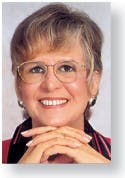Swine flu is here. Despite ongoing news coverage of
global statistics on swine-flu victims and fatalities, are we really
ready for A/H1N1? Ben Franklin said: “Failing to prepare is preparing to
fail.” Old Ben is probably rolling in his penny-covered grave about now.
My garage is still full of packed boxes from my April move. Not one
container of water, can of tuna, or jar of peanut butter have I stocked
there as preparation for the swine flu. Not a single flu mask graces my
work “junk” drawer, and my hand sanitizer dried up. I hear the
now-angelic Beverly Sills' warbling her famous quip: “You may be
disappointed if you fail, but you are doomed if you don't try.”
But by early August throughout the healthcare
industry, many demonstrated positive signs of flu preparedness. Vaccines
for the flu, says the WHO, are coming in limited batches this month; a
second delivery of vaccine is expected in late October. A little nip of
a A/H1N1 vaccine to top off our protection is just the preparedness
ticket. Other preparedness involved activities of at least five U.S.
flu-testing manufacturers who were kickin' it up a notch (space is too
limited to expound on every entity).
Focus Diagnostics received an FDA emergency-use
authorization for its Influenza A H1N1 (2009) RT-PCR. Luminex also
updated its xTAG Respiratory Viral Panel with FDA clearance to reflect
that it can be used as an aid in detecting 2009 Influenza A/H1N1 but
cannot ID the hemagglutinin (the “H” in H1N1) gene of that specific flu
in clinical specimens.
Quidel's QuickVue Influenza A+B test, BD's Directigen
EZ Flu A+B kit, and Inverness Medical BinaxNOW Influenza A&B test from
Binax were tested by the CDC on 65 clinical specimens. Some folks who
put their best feet forward got their little rapid-testing toes stepped
on when reporters-turned-naysayers headlined articles like “Rapid tests
miss mark for pandemic H1N1 flu,” leaving until last the fact that the
CDC said:
- the level of virus in samples can be affected by
when in the disease course the sample was taken, the patient's age,
manner of storage and transportation; - the findings were limited because, for each test,
relatively few clinical specimens were evaluated across the range of
cycle threshold values; and - that another limitation was … the specimens were
not tested immediately after collection but were stored and shipped
to the CDC under varying conditions.
Despite these “interferences,” these rapid tests
accurately typed between 40% to 69% of 45 clinical specimens known to
contain the pandemic flu strain.
Like now-angelic Bev said: “You may be disappointed
if you fail, but you are doomed if you don't try.” So, Quidel, for one,
further ratcheted up for flu season with an educational online
presentation (see p. 38) for use with its rapid flu test.
Hall of Football Famer Roger Staubach was fond of
saying, “In business or in football, it takes a lot of unspectacular
preparation to produce spectacular results.” He may as well have added
medical labs, too, where it also takes a lot of unspectacular
preparation to produce spectacular results. Flu-testing
manufacturers will tell you the same thing about developing flu test
kits.
Getting prepared is spectacularly
unspectacular, but thanks to the Quidels, the BDs, the Binaxes, the
Quest/Focuses, the Luminexes, and others of equal stature in the medical
laboratory world who are not afraid to try and try again, we are all on
the road toward being better prepared for this and the next flu season.




